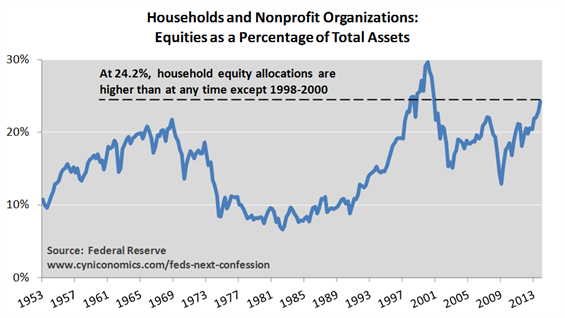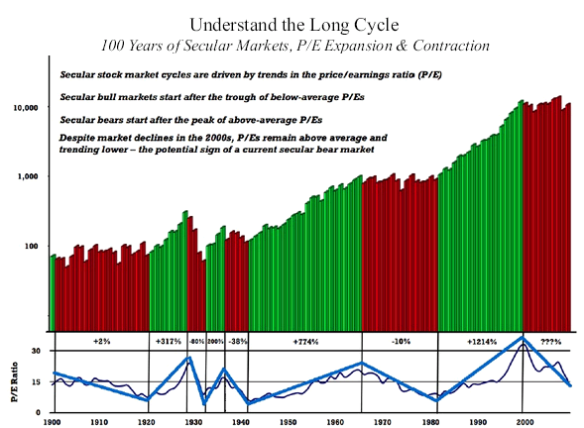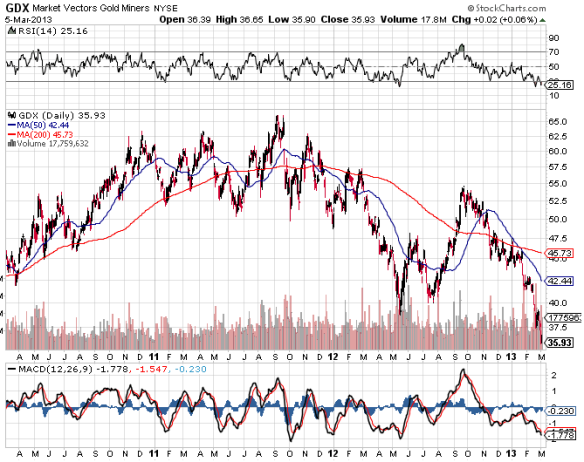We finally have a weakening trend on the daily RSI (see RSI on bottom of chart). This is a prerequisite for anyone considering taking a short position, especially with leverage.
It would be typical for some type of quick plunge to develop soon, perhap on the order of 5-8% in SPX, maybe 100 points (1000 Dow points). It would also be typical for stocks to recover from such a plunge and test the highs again, as in spring 2011 or Summer-Fall 2007. In May 2010, this process was compressed in the “Flash Crash,” which was followed quickly by a decline of around 20%.

However, the weekly trend is still up, though finally in overbought territory. Perhaps this begins to turn over the next few weeks as the market chops sideways.

Further strengthening the bear case is sentiment, which has now been elevated for at least two months (I recommend sentimenttrader.com at $30/month for all you can eat indicators). Sentiment is a powerful indicator, but actual price tops lag tops in sentiment by several weeks to months, as prices tend to levitate and chop sideways for a while on weakening RSI prior to major declines. Bottoms have a much closer time relationship to sentiment (extreme bearishness among traders is usually quickly followed by rallies).
The best free sentiment resource that I am aware of is the NAAIM Survey of Manager Sentiment. As you can see in the chart below, sustained bullish sentiment is required in order to register a valid sell signal, as the crowd is often right for a while. The relatively short period of bullishness here is another sign that any decline that develops soon could be short-lived.

I should also mention that John Hussman has noted that the market has exhibited his syndrome of overbought, overvalued, overbullish on rising yields, for several weeks now. This set of conditions coincides with many of the very worst times to be long stocks, and has almost no false positives. Advances made during such periods are soon given up, often in severe declines.
The following set of conditions is one way to capture the basic “overvalued, overbought, overbullish, rising-yields” syndrome:
1) S&P 500 more than 8% above its 52 week (exponential) average
2) S&P 500 more than 50% above its 4-year low
3) Shiller P/E greater than 18
4) 10-year Treasury yield higher than 6 months earlier
5) Advisory bullishness > 47%, with bearishness < 27% (Investor’s Intelligence)
[These are observationally equivalent to criteria I noted in the July 16, 2007 comment, A Who’s Who of Awful Times to Invest. The Shiller P/E is used in place of the price/peak earnings ratio (as the latter can be corrupted when prior peak earnings reflect unusually elevated profit margins). Also, it’s sufficient for the market to have advanced substantially from its 4-year low, regardless of whether that advance represents a 4-year high. I’ve added elevated bullish sentiment with a 20 point spread to capture the “overbullish” part of the syndrome, which doesn’t change the set of warnings, but narrows the number of weeks at each peak to the most extreme observations].
The historical instances corresponding to these conditions are as follows:
December 1972 – January 1973 (followed by a 48% collapse over the next 21 months)
August – September 1987 (followed by a 34% plunge over the following 3 months)
July 1998 (followed abruptly by an 18% loss over the following 3 months)
July 1999 (followed by a 12% market loss over the next 3 months)
January 2000 (followed by a spike 10% loss over the next 6 weeks)
March 2000 (followed by a spike loss of 12% over 3 weeks, and a 49% loss into 2002)
July 2007 (followed by a 57% market plunge over the following 21 months)
January 2010 (followed by a 7% “air pocket” loss over the next 4 weeks)
April 2010 (followed by a 17% market loss over the following 3 months)
December 2010
This chart from Hussman has data through March 3, but the latest blue band is now about a month wider:

–
This is clearly time to exit stocks or hedge all market risk. The upside is limited relative to the downside.
 Hat tip Cyniconomics
Hat tip Cyniconomics























